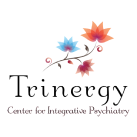Panchakarma for Physical and Mental Wellbeing
In Ayurveda, health has a positive definition. It is not just an absence of disease or disability. Health is viewed as a dynamic and vital state; a state of balance and harmony within the individual and of balance amongst the three Doshas – Vata, Pitta and Kapha.
Health, in Ayurveda, is defined as the body being clear of toxins, the mind at peace, emotions being calm, mood being blissful and happy, wastes efficiently eliminated, and all internala organs functioning optimally. This positive state of vitality is achieved by maintaining a balance of the three Doshas.

The chronic state of stress
According to Ayurveda, diseases manifest when this delicate balance between the Doshas is disturbed. In today’s fast-paced world, stress is ubiquitous! This chronic state of stress (along with junk, chemical laden, processed food) reduces the digestive fire which leads to undigested or partially digested food. This undigested food triggers local inflammation, gut dysbiosis and eventually leads to creation, accumulation, and absorption of toxins (Ayurvedic term for toxin is “Ama”) from the gut into the rest of the body. In a circular way, the accumulating toxins cause further deterioration of the digestive fire and other bodily functions which weakens our systems and sets the stage for chronic, inflammatory or degenerative diseases; to develop. This is Ayurvedic theory of disease formation in one paragraph ?.
Ayurveda recommends seasonal purification treatments to cleanse the body of such accumulated toxins and to restore the digestive fire (which is central to health and vitality). One of the foremost of such treatments is known as Panchakarma. In fact, Panchakarma is the go-to treatment for health maintenance as well as for root cause removal of many chronic illnesses.
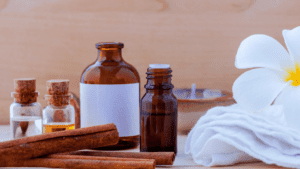
Panchakarma (PK) Ayurveda detoxification
Panchakarma (PK) can help by reversing the negative effects of daily living. It can restore one’s natural state of health and wellness by cleansing the body of toxins, restoring digestive fire, bringing balance within and improving bodily functions. An extremely important benefit of PK in today’s world is its ability to eliminate petro-chemical toxins we are constantly bombarded with – from pesticides in food to chemical toxins in cosmetics, body products, environment, etc.
Ayurvedic Treatments are of 2 Types:
- Shamana treatments are mainly for symptom relief. Eg: Massage for musculoskeletal pain.
- Shodhana treatments are for removing the underlying root cause. If a disease is treated with the Shodhana approach, recurrence is extremely low because the underlying root cause is removed. The patient then must only ensure that the root causes do not accumulate within her/him. Thus, Shodhana therapies are the ultimate way to heal and re-balance the body.
PK is the foremost of Shodhana therapies. PK is beneficial for almost all disease states, provided the patient can participate and tolerate the therapy.
What are the Benefits of Panchakarma?
- Cleanses toxins from the entire system
- Strengthens immune system, restores Ojas (vital energy), increases immunity and resistance to illness
- Restores strength and vitality of digestive fire (Agni)
- Balances the three Doshas
- Decreases stress and effects of stress.
- Improves skin luster
- Enhances deep relaxation of nervous system and musculature.
- Enhances mindfulness
- Weight loss (only if overweight or obese. Normal weight individuals will not see much change in their weight)
When is Panchakarma Indicated?
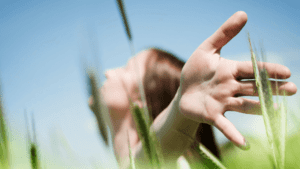
Annual purification treatment
PK is best incorporated as annual (seasonal) purification treatment for purposes of health maintenance. But it is also recommended for the following symptoms. As you will see, these are symptoms of chronic stress, chronic inflammation or endocrine imbalance. I would like to clarify here that without diet, lifestyle changes; PK can be limited in its effectiveness. PK may remove the toxins and imbalances and provide temporary relief; but if diet and lifestyle factors (or any other causes) that contributed to the illness in the first place are not removed, then disease symptoms will recur.
Indicators for PK are:
- Mind fog
- Uncontrollable cravings
- Symptoms of fatigue and low energy; especially after meals.
- Bad breath, body odor, flatulence
- Constipation or diarrhea
- Body aches and pains: Chronic or acute pain
- All autoimmune conditions
- Poor focus, concentration, short term memory difficulties
- Weight gain (overweight to obese)
- Sad mood, anxiety, insomnia.
- Indecisiveness
- Imbalance in the Doshas (could be with one, two or all three Doshas)
- Finally, any diagnosis of chronic disease (physical or mental).
Panchakarma is a Sanskrit word that means “five (Pancha) actions (Karma)”. Here is more info about PK and what to expect with Trinergy’s PK therapy. Firstly, at Trinergy, PK is provided under the expert guidance of our Vaidya (Ayurveda doctor) Sunita Pandey. In fact, Vaidya Pandey has her MD in Panchakarma. So, rest assured that you are in very safe, capable and expert hands!
Panchakarma Steps
There are a few different steps within PK. Please note that this is a general overview. Ayurveda is all about personalized medicine. As such, the following steps may be tweaked/altered for patients based on their presentation and needs.
1. Poorvakarma – Preparatory Phase
This preparatory procedure is required before the main treatment. May begin a few weeks before the main treatment phase. Goal of this phase is to soften the tissues; so that the lipid-soluble toxins deposited into them are liquefied and mobilized back to the digestive tract to be eliminated.
One of the main goals of this phase is to incorporate Pachana-karma. Pachana means digestion. Pachana-karma means stimulating the digestive fire.
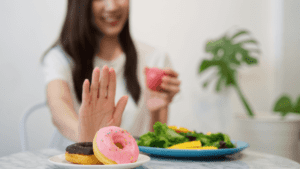
4-6 week elimination diet
To achieve this, we start with a 4-6 week elimination diet. At Trinergy, we follow IFM (Institute for Functional Medicine) guidelines and recipes for the elimination diet. This diet will reduce inflammation triggered by faulty diet habits. The nutrient dense diet will also begin to restore nutrients to the body.
Targeted supplements (Ayurvedic herbals and nutritional supplements) as recommended by the Vaidyas or by Dr Tummala; will help with Doshic balance, nutrient restoration as well as with cellular detoxification.
Other dietary recommendations (intermittent fasting or Dosha specific diets, etc) may be recommended as per individual patients’ needs.
Lifestyle changes like meditation, exercise, breathing exercises (Pranayama) may also be recommended during this phase.
In addition, regular (weekly to biweekly) Snehana Karma or Abhyanga massage along with Swedana Karma or herbal steam sauna (see below for more info) is recommended – again with the goals of softening tissues, liquefying and mobilizing the fat-soluble toxins; and aiding their elimination as much as possible. Other Ayurvedic therapies like Shirodhara, Udwarthan, Herbal poultice therapy, etc; may be recommended based on individual patient needs.
During this phase, with all the above inputs, patient is mentally and physically prepared for the main procedure of panchakarma.
Most patients begin to notice symptomatic improvement in this phase itself – mainly with improving digestive abilities!
Ghee (clarified butter – choose organic always) is recommended as preferred dietary fat as ghee is regarded as a detoxifying fat in Ayurveda. Ayurvedic texts describe that ghee has the ability to liquefy the fat-soluble toxins, bind with them and move them into the channels of elimination.
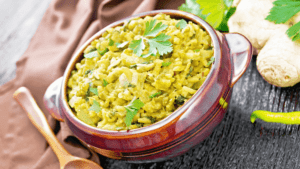
Kitchari diet
Kitchari diet (recipe as per Trinergy guidelines) is then recommended close to the start of actual PK therapies. At Trinergy, most patients begin their PK series on a Tuesday. Hence, we recommend that Kitchari diet to be started the preceding Saturday or Sunday.
Adherence to kitchari diet is an absolute necessity for success of PK. Kitchari is a dish made by cooking yellow lentils (split and dehusked mung bean) and white basmati rice with a blend of medicinal spices and herbs; coupled with increasing amount of ghee each dayPanchakarma is the go-to treatment for health maintenance as well as for root cause removal of many chronic illnesses.. Every ingredient of this dish has a specific purpose and hence, it must be adhered to. As the main PK therapies are progressing, the Vaidyas will routinely evaluate the patient and adjust Kitchari diet accordingly. Some vegetables like carrots, French beans, etc may be added on day 3 or 4 of PK.
2. Pradhanakarma – Main Treatment Phase
There are a few regional variations in the panchakarma procedures (based on what part of India the Vaidya is trained from). It remains highly individualized for the patient; depending on the needs, age, digestive strength, immune system and other factors.
Pradhanakarma refers to the main part of PK – the 7 sessions that are recommended at Trinergy, where we start with Snehana Karma or Abhyanga massage and Swedana Karma or Herbal Steam Sauna.
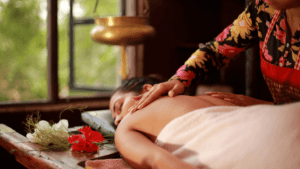
Snehana Karma (Abhyanga massage)
Snehana Karma (Abhyanga) – Snehana refers to massaging the whole body using an appropriate oil (according to the dosha aggravation). Warm Oil massage makes the superficial and deep tissues soft and supple, liquefies the fat-soluble toxins for elimination. The massage technique is such that it induces deep relaxation, removes stress and nourishes the nervous system. It helps to soothe vata imbalances which will bring deep relaxation to the body and a peaceful mind. It also improves the condition of dry, course hair and flaky skin.
Other benefits include:
- Calmer nerves
- Improved stamina and alertness throughout the day
- Deeper, better sleep
- Detoxifies the body
- Helps in healthy weight management
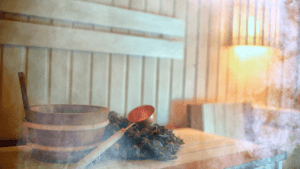
Swedana Karma (herbal steam)
Swedana Karma (Herbal Steam) – Swedana has relaxing and detoxifying effects on the human body. It is given every day immediately after the snehana procedure. After Swedana, specific panchakarma method is administered to the patient according to the individual’s constitution (Prakriti) and disorder (vikriti).
The benefits of the steam bath include:
- Aids in draining toxins from deep tissues
- Helps in eliminating toxins through sweating
- Improves blood circulation
- Helps with weight loss
- Provides healthier skin
- Helps to cleanse the respiratory system
- Reduces stress
- Aids in unblocking sinuses
- Reduces numbness, stiffness, rigidity, heaviness and improves mobility
Nasya (Detoxification Through the Nose)
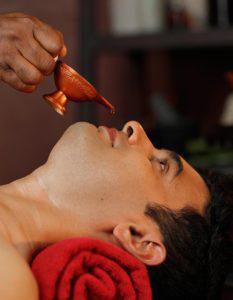
Nasya therapy
The administration of medicated oil (customized for each person after assessing their body constitution) through the nose is called Nasya. It is considered that the nasal passage is the doorway to the brain; and it is also the doorway to consciousness. A oneness of bodily humors which is accumulated in the sinus, throat, nose or head is expelled through the nearest opening, the nose.
Prana (life force or chi in Chinese medicine) enters the body through the nose. Prana helps to supply a sufficient amount of oxygen needed for the entire body to function normally. Prana is the energy in the brain and helps to maintain sensory and motor functions. It helps in governing mental activities, memory, concentration and intellectual activities.
The benefits of nasya include:
- Helps to cleanse and clear nasal passages
- Lubricates the nasal passages and nourishes the cell lining
- Relieves fatigue
- Improves vision
- Improves cognition and boosts brain function
- Protects against premature aging
- Aids in treating disorders related to the nose, mouth, eye, head and ears
- Improves cerebral circulation
Basti (or Vasti) Enema Therapy: Colon Cleanse
Vata’s predominant site is in basti, or the colon. Ayurvedic basti (enema) involves the rectal administration of an herbal concoction with base of sesame oil. There are 2 types of Basti:
- Sneha basti – basti prepared using oils; and
- Kashaya basti – basti prepared using herbal decoctions
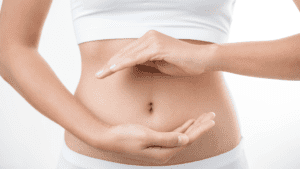
Colon cleanse
In Ayurveda, basti plays a major role and hence, basti is considered as half of the panchakarma procedures. Though vasti is considered as the best treatment for vata, Sushruta (one of founding fathers of Ayurveda and widely regarded as father of plastic surgery in India) further praised that vasti is beneficial not only in diseases due to vata, but also in diseases caused by aggravated pitta, kapha, or in conditions where in 2 or all 3 of the Doshas are imbalanced. (samsarge is dual Dosha vitiation and sannipata is when all three Dosha vitiation is present).
Action of Vasti
The active principles in vasti formulations spreads all over the body through the microchannles in the same way water reaches all parts of the plant from its root and bring all the vitiated doshas to intestine to expel them out along with feces.
Benefits of Vasti Include:
- Helps to lubricate and nourish the lower gastrointestinal tract
- Enhances the immune system of the individual
- Helps to put the body into a state of total balance by nourishing the base prana of the body which is formed in the colon
You can double the Effect of Panchakarma by eating right:
According to Ayurveda, diet plays a central role in maintaining a disease-free life. During panchakarma procedures agni (digestive fire) will be less. So, it is always advisable to be on a gut friendly diet which also helps in regaining the digestive fire. Ama is a product of incomplete digestion – it represents sticky toxic matter that can close the channels of your body that carry nutrients to the cells and waste out of the body. You will want to stay away from foods that build more ama in the body.
According to Ayurveda, leftovers and dead foods such as processed, packaged, canned and frozen foods all create ama because they are very hard for the body to digest. Also, heavy dairy products, fried or oily foods, raw foods, heavy desserts, yeasted breads, dry breads such as crackers and fermented foods; have the same potential to create more Ama.
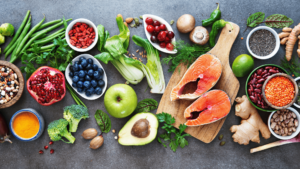
Diet plays an essential role
Food that can be included in your diet are fruits (mainly cooked prunes and figs) in general most sweet juicy fruits are excellent cleansers, vegetables with detox spices and are perfectly cooked, grains like quinoa, barley, rice boiled with lots of water is an excellent hot beverage for flushing out of toxins and also spices like ginger, turmeric, coriander, fennel and fenugreek can be used. It is always appreciated to drink plenty of warm water throughout the detoxification program.
It is recommended to continue the panchakarma diet or kitchari diet for at least a week after your detoxification program. Later on, through post PK consults, our Vaidyas will guide you to reintroducing other foods that are good for you. Regular follow up in the successive months will ensure that you are able to maintain a healthy lifestyle.
Eventually, you will make your way to eating a balanced diet and maintaining a disease free state!!!
